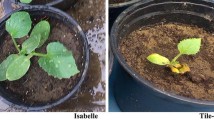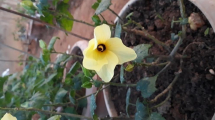Abstract
Melon (Cucumis melo L.) is an important popular high-consumption product in the world. Melon Fusarium wilt (Fusarium oxysporum f.sp. melonis: FOM) is a global destructive disease. In this research, 88 melon landraces from different geographical regions of Iran together with reference genotypes as control genotypes were screened for resistance to 0 and 1 races of Fusarium wilt disease agent using artificial inoculation and two functional markers for the presence or absence of Fom-2 gene. The landraces in multiple replicates were examined in a greenhouse experiment. Thirty-five out of the 88 landraces were selected to determine the disease incidence percentage (DIP), disease severity percentage (DSP) and area under disease progress curve (AUDPC). Based on the results of marker-assisted selection, 83 genotypes had at least one susceptible allele, while 43 heterozygote genotypes had at least one resistance allele. Among genotypes evaluated in artificial inoculation test, three landraces including Shahd-e-Shiraz Gosht Narenji, Korki and Alam Gorgor indicated the highest level of resistance. It seems that these landraces can be considered as the most useful sources of resistance in breeding programs for introducing Fusarium resistant melons. In contrast, Jalali, Petra falat and Habib-Abad landraces were the most sensitive genotypes, which can be used to produce sensitive standard check lines.



Similar content being viewed by others
References
Alvarez JM, González-Torres R, Mallor C, Gómez-Guillamón ML (2005) Potential sources of resistance to Fusarium wilt and powdery mildew in melons. HortScience 40(6):1657–1660. https://doi.org/10.21273/HORTSCI.40.6.1657
Banihashemi Z (2010) Reaction of Cucumis melo cultivars to races of Fusarium oxysporum f.sp. melonis the cause of melon vascular wilt. Iran J Plant Pathol 46(1)
Banihashemi Z, DeZeeuw D (1975) The behavior of Fusarium oxysporum f.sp. melonis in the presence and absence of host plants [Muskmelons, fungus diseases]. Phytopathology (USA)
Baudracco-Arnas S (1995) A simple and inexpensive method for DNA extraction from Cucumis melo L. Rep Cucurbit Genet Coop 18:50–51
Baudracco-Arnas S, Pitrat M (1996) Melon mapping by molecular markers and disease resistance genes. Selectionneur Francais (France)
Brimner TA, Boland GJ (2003) A review of the non-target effects of fungi used to biologically control plant diseases. Agr Ecosyst Environ 100(1):3–16. https://doi.org/10.1016/S0167-8809(03)00200-7
Cebolla V, Busto J, Ferrer A, Miguel A, Maroto V (2000) Methyl bromide alternatives on horticultural crops. Paper presented at the International Symposium on Chemical and Non-Chemical Soil and Substrate Disinfectation 532. https://doi.org/10.17660/ActaHortic.2000.532.32
Chikh-Rouhou H, Álvarez J, González-Torres R (2007) Differential interaction between melon cultivars and race 1.2 of Fusarium oxysporum f.sp. melonis. Appl Biol Res
Crinò P, Bianco CL, Rouphael Y, Colla G, Saccardo F, Parator A (2007) Evaluation of rootstock resistance to Fusarium wilt and gummy stem blight and effect on yield and quality of a grafted ‘Inodorus’ melon. HortScience 42(3):521–525. https://doi.org/10.21273/HORTSCI.42.3.521
Egel (2007) Fusarium wilt of watermelon and other cucurbits
FAO (2018) FAOSTAT agricultural database. http://faostat3.fao.org/faostat-gateway/go/to/download/Q/QC/E
Gao P, Liu S, Zhu Q, Luan F (2015) Marker-assisted selection of Fusarium wilt-resistant and gynoecious melon (Cucumis melo L.). Genet Mol Res 14(4):16255–16264. https://doi.org/10.4238/2015
Garcia-Mas J, Benjak A, Sanseverino W, Bourgeois M, Mir G, González VM, Hénaff E, Câmara F, Cozzuto L, Lowy E (2012) The genome of melon (Cucumis melo L.). Proc Natl Acad Sci U S A 109(29):11872–11877. https://doi.org/10.1073/pnas.1205415109
Gordon T, Okamoto D, Jacobson D (1989) Colonization of muskmelon and nonsusceptible crops by Fusarium oxysporum f.sp. melonis and other species of Fusarium. Phytopathology 79(10):1095–1100
Joobeur T, King JJ, Nolin SJ, Thomas CE, Dean RA (2004) The fusarium wilt resistance locus of melon contains a single resistance gene with complex features. The Plant Journal 39(3):283–297
Koch R, Pinner BR, Pinner M (1932) The aetiology of tuberculosis: National Tuberculosis Association, New York
Madadkhah E, Lotfi M, Nabipour A, Rahmanpour S, Banihashemi Z, Shoorooei M (2012) Enzymatic activities in roots of melon genotypes infected with Fusarium oxysporum f.sp. melonis race 1. Sci Hortic 135(0):171–176. https://doi.org/10.1016/j.scienta.2011.11.020
Madden L, Campbell C (1990) Nonlinear disease progress curves. In Epidemics of Plant Diseases (pp. 181–229): Springer, Berlin. https://doi.org/10.1007/978-3-642-75398-5_6
Martyn R, Gordon T (1996) Fusarium wilt of melon. Compendium of Cucurbit Diseases 14–15
Mas P, Molot P, Risser G (1981) Fusarium wilt of muskmelon. Fusarium: Disease, Biology and Taxonomy, pp 169–177
Normantovich M, Yogev O, Taylor CG, Perl-Treves R (2012) Study of the Fom-2 resistance gene using composite melon plants. Paper presented at the Cucurbitaceae 2012. Proceedings of the Xth EUCARPIA Meeting on Genetics and Breeding of Cucurbitaceae, Antalya, Turkey, 15–18 October, 2012
Oumouloud A, Álvarez JM (2016) Breeding and genetics of resistance to Fusarium wilt in melon. Advances in plant breeding strategies: Agronomic, abiotic and biotic stress traits (pp. 601–626): Springer, Berlin. https://doi.org/10.1007/978-3-319-22518-0_16
Oumouloud A, Arnedo-Andrés M, González-Torres R, Alvarez J (2009) Morphological and molecular characterization of melon accessions resistant to Fusarium wilts. Euphytica 169(1):69–79. https://doi.org/10.1007/s10681-009-9942-3
Oumouloud A, Arnedo-Andrés M, González-Torres R, Álvarez J (2010) Inheritance of resistance to Fusarium oxysporum f.sp. melonis races 0 and 2 in melon accession Tortuga. Euphytica 176(2):183–189. https://doi.org/10.1007/s10681-010-0201-4
Oumouloud A, Mokhtari M, Chikh-Rouhou H, Arnedo-Andrés M, González-Torres R, Álvarez J (2012) Characterization of the Fusarium wilt resistance Fom-2 gene in melon. Mol Breed 30(1):325–334. https://doi.org/10.1007/s11032-011-9622-6
Oumouloud A, El-Otmani M, Chikh-Rouhou H, Claver AG, Torres RG, Perl-Treves R, Álvarez J (2013) Breeding melon for resistance to Fusarium wilt: recent developments. Euphytica 192(2):155–169. https://doi.org/10.1007/s10681-013-0904-4
Park DK, Son SH, Kim S, Lee WM, Lee HJ, Choi HS, Yang EY, Chae WB, Ko HC, Huh YC (2013) Selection of melon genotypes with resistance to Fusarium wilt and Monosporascus root rot for rootstocks. Plant Breed Biotech 1(3):277–282. https://doi.org/10.9787/PBB.2013.1.3.277
Pitrat M, Dogimont C, Bardin M (1998) Resistance to fungal diseases of foliage in melon. Paper presented at the Cucurbitaceae
Ramkumar G, Prahalada G, Hechanova SL, Vinarao R, Jena KK (2015) Development and validation of SNP-based functional codominant markers for two major disease resistance genes in rice (O. sativa L.). Mol Breed 35(6):129. https://doi.org/10.1007/s11032-015-0323-4
Risser G, Banihashemi Z, Davis D (1976) A proposed nomenclature of Fusarium oxysporum f.sp. melonis races and resistance genes in Cucumis melo [Muskmelon, fungal diseases]. Phytopathology (USA)
Rodríguez-Moreno L, González VM, Benjak A, Martí MC, Puigdomènech P, Aranda MA, Garcia-Mas J (2011) Determination of the melon chloroplast and mitochondrial genome sequences reveals that the largest reported mitochondrial genome in plants contains a significant amount of DNA having a nuclear origin. BMC Genom 12(1):424. https://doi.org/10.1186/1471-2164-12-424
Sela H, Spiridon LN, Petrescu AJ, Akerman M, Mandel-Gutfreund Y, Nevo E, Loutre C, Keller B, Schulman AH, Fahima T (2012) Ancient diversity of splicing motifs and protein surfaces in the wild emmer wheat (Triticum dicoccoides) LR10 coiled coil (CC) and leucine‐rich repeat (LRR) domains. Mol Plant Pathol 13(3):276–287. https://doi.org/10.1111/j.1364-3703.2011.00744.x
Sherf AF, MacNab AA (1986) Vegetable diseases and their control. Wiley, Hoboken
Stepansky A, Kovalski I, Perl-Treves R (1999) Intraspecific classification of melons (Cucumis melo L.) in view of their phenotypic and molecular variation. Plant Syst Evol 217(3–4):313–332. https://doi.org/10.1007/BF00984373
Teimouri S, Rahnama K, Hajian shahri M, Afzali H (2013) Identification, distribution and pathogenicity of Fusarium species isolated from root and crown of cantaloupe and melon in Khorasan Razavi province. Iran J Plant Pathol 1(3):33–44
Tezuka T, Waki K, Kuzuya M, Ishikawa T, Takatsu Y, Miyagi M (2011) Development of new DNA markers linked to the Fusarium wilt resistance locus Fom-1 in melon. Plant Breed 130(2):261–267. https://doi.org/10.1111/j.1439-0523.2010.01800.x
Wang S, Yang J, Zhang M (2011) Developments of functional markers for Fom-2-mediated Fusarium wilt resistance based on single nucleotide polymorphism in melon (Cucumis melo L.). Mol Breed 27(3):385–393. https://doi.org/10.1007/s11032-010-9439-8
Wang X, Xu B, Zhao L, Gao P, Ma H, Luan F (2014) Expression analysis of Fusarium wilt resistance gene in melon by real-time quantitative PCR. Pak J Bot 46(2):713–717
Zink F (1991) Origin of Fusarium wilt resistance in Texas AES muskmelon cultivars. Plant Dis 75(1):24–26. https://doi.org/10.1094/PD-75-0024
Zink F, Thomas C (1990) Genetics of resistance to Fusarium oxysporum f.sp. melonis races 0, 1, and 2 in muskmelon line MR-1. Phytopathology 80(11): 1230–1232. https://doi.org/10.1094/Phyto-80-1230
Zheng X, Wolff D (2000) Development of a SCAR marker-associated with Fusarium wilt resistance and the evidence of its segregation with the Fom-2 gene in melon (Cucumis melo L.). Journal of the Rio Grande Valley Horticultural Society, Subtropical Plant Science
Acknowledgements
This article has been extracted as a part of Ph.D. dissertation of the first author. We thank the University of Guilan for providing financial supports and executive facilities of this research.
Author information
Authors and Affiliations
Corresponding author
Ethics declarations
Conflict of interest
The authors declare that there is no conflict of interest.
Rights and permissions
About this article
Cite this article
Mahdavi Meighan, A., Rabiei, B. & Khodaparast, S.A. Identification of Fusarium wilt resistance sources in melon (Cucumis melo L.) landraces of Iran using marker-assisted selection technique. Australasian Plant Pathol. 49, 413–423 (2020). https://doi.org/10.1007/s13313-020-00713-9
Received:
Revised:
Accepted:
Published:
Issue Date:
DOI: https://doi.org/10.1007/s13313-020-00713-9




